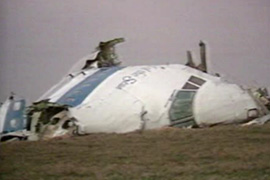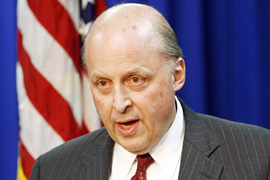Timeline: Libya-US relations
Condoleezza Rice, the US secretary of state, makes an historic visit to Libya

 |
| Muammar Gaddafi has ruled Libya since he led a small group of military officers in a bloodless coup that overthrew King Idris I in 1969 [AFP] |
Condoleezza Rice, the US secretary of state, will be the highest-ranking official to visit Libya since John Foster Dulles, the secretary of state in the Eisenhower administration, in 1953.
Rice’s diplomatic mission on September 5 comes shortly after an agreement was concluded for both countries to pay reparations for American and Libyan citizens killed and injured during brief armed conflict in the 1980s.
The following are key events in Libyan-US relations:
1934: Italy adopts the name Libya to refer to the provinces of Cyrenia, Tripolitania and Fezzan, which it had colonised. Over the next 15 years, the territories are variously controlled by the French and administered by the British.
1943: During World War II, the British capture Mellaha Air Base near Tripoli. It is used by the US military from the spring of 1943 onwards, and subsequently renamed Wheelus Air Base. Over the next decade, various agreements are signed permitting the US continued use of the base.
1947: Italy relinquishes all claims to Libya under the allied peace treaty.
1949: The United Nations passes a resolution stating that Libya should become independent before January 1, 1952.
December 24, 1951: Libya declares independence. The country was proclaimed a constitutional and hereditary monarchy under the rule of King Idris I.
1959: Oil is discovered in Libya.
September 1, 1969: Muammar Gaddafi leads a coup to unseat the monarchy and Idris goes into exile in Egypt.
1970: The new Libyan government seeks to terminate the presence of foreign troops on its soil and asks foreign governments to withdraw; British and US military installations are closed, including the US Wheelus Air Force Base.
1972: US withdraws its last Ambassador to Libya.
February 21, 1973: Tripoli-bound Libyan Arab Airlines Flight 114 from Cairo is severely damaged by Israeli fighter jets over the Sinai. 110 passengers and crew are killed when the plane is forced to make an emergency landing in uneven desert terrain. The plane had become lost due to a sandstorm and inadvertently flew into Sinai’s airspace, which was then controlled by Israel.
1979: An angry mob chanting pro-Iran slogans attacks and sets fire to the US embassy in Tripoli, after which the embassy was shut down. Twenty days later, the US designated Libya a state sponsor of terrorism.
1980: US declares four Libyan diplomats persona non grata and recalls its two remaining diplomats from Libya, effectively ending ties.
1981: Two Libyan fighter jets are shot down by the US air force flying over the Gulf of Sirte, which Libya had claimed as its territorial waters. The US disputed this claim.
1986: US naval aircraft participating in exercises in the Gulf of Sirte come under fire from Libyan surface-to-air missiles. Two Libyan patrol boats are sunk by US navy warplanes and a Libyan missile base in Sirte is attacked.
April 5, 1986: Libya is blamed for the April 5 bombing of La Belle discotheque in West Berlin, which was frequented by US military personnel. Three people were killed, including two US servicemen, and more than 200 people were injured, including more than 50 US service personnel. A Libyan diplomat is subsequently convicted of aiding in murder when tried in 2001, along with four other defendants, two of whom were non-national Libyan embassy employees.
April 14: Ronald Reagan, the then-US president, orders a strike on April 14. Attacks on military installations and residential areas of Tripoli and Benghazi killed and wounded dozens of people, including Gaddafi’s 15-month-old adopted daughter. Gaddafi escapes injury, but two of his sons are also injured.
 |
| The bombing of Pan Am Flight 103 over Lockerbie in 1988 killed 270 people |
1988: 270 people are killed when Pan Am Flight 103 is bombed en route from London to New York, over Lockerbie in Scotland. Some 180 of those killed were US nationals.
1989: In an incident echoing that of 1981, two Libyan fighterjets are shot down by US naval aircraft in the Gulf of Sidra.
1992 & 1993: The UN adopts and imposes sanctions against Libya, after the country failed to cooperate with investigations into the Lockerbie bombing and the suitcase bombing of French UTA Flight 772 over Niger that killed 170 people in 1989. These included travel restrictions, an arms embargo, and financial sanctions.
1999: Libya surrenders to the UN two Libyan intelligence officers suspected of involvement in the Lockerbie bombing. The UN suspended sanctions imposed several years earlier.
2001: At the trial of two Libyans at a special court in the Netherlands under Scottish law, Abdelbaset Ali Mohmed Al Megrahi is sentenced to life. The other Amin Khalifa Fhimah is found not guilty and freed. (Al Megrahi has maintained his innocence and in June 2007 the Scottish Criminal Cases Review Commission stated that in referring the case for appeal they were satisfied a miscarriage of justice may have occurred and that he is entitled to a second appeal against his conviction. As at September 2008, Al Megrahi’s lawyers are preparing his appeal.)
March 2003: Libya is elected chair of the UN Human Rights Commission. The US and human rights groups oppose this appointment.
August 2003: The UN lifted sanctions after Libya “accepted responsibility for the actions of its officials” for the 1988 bombing over Lockerbie in Scotland, renounced terrorism, and agreed to pay $2.7 billion compensation to the victims’ families.
September: The UN Security Council votes to lift sanctions on Libya. The US and France abstain.
December: Libya announces it is dismantling its weapons of mass destruction programme.
In the same month, the International Atomic Energy Agency (IAEA) reports there are no signs Libya had enriched uranium, a precursor to making a bomb. The IAEA said US and British assertions that Tripoli was close to developing a nuclear weapon may have been exaggerated.
February 2004: A limited US diplomatic presence is reintroduced and later upgraded to a liaison office in June. The following month, Libya opened a liaison office in Washington DC. The US lifted most of its unilateral sanctions in September.
2005: George Bush, the US president, waives some defence export restrictions to allow US companies to participate in destroying Libya’s chemical weapons.
May 2006: The US restores full diplomatic ties with Tripoli as a reward for Libya dismantling of its weaponisation programme. The restoration of ties was expected to pave the way for business dealings between the two countries. The US removed Libya from the state department’s list of nations that sponsor terrorism and opened an embassy in Tripoli.
March 2007: Libyan parliamentary body authorised the signing of a deal under which the US would help the country build its first-ever nuclear power plant for civilian use.
In the same month, Gaddafi boycotts an Arab League Summit in Riyadh, saying the US sets its agenda. The Libyan leader said Rice “gives orders” to Arab leaders, and they should stay at home rather than attend the summit.
 |
| John Negroponte, the US deputy secretary of state, visited Libya in 2007 |
April: John Negroponte, the US deputy secretary of state, visits Libya. Though he was the highest-ranking US official to visit the country in half a century, he was snubbed by Gaddafi. The Libyan leader declined to meet Negroponte, instead choosing to meet lower ranking officials.
April: Libya hosts talks on Darfur in the coastal city of Sirte, about 500km east of the capital Tripoli. UN, US, EU and African Union officials attend.
July: Bush nominates Gene Cretz as ambassador to Libya. Cretz becomes the first US ambassador to Libya in 35 years. This nomination was blocked by Democrats, who said they would invoke a Senate procedure until Libya pays compensation for terrorist attacks in the 1980s. As of September 2008, the position remains vacant.
March 2008: While attending the annual Arab League Summit, Gaddafi criticised Arab countries for doing nothing as the US invaded Iraq in 2003 and overthrew Saddam Hussein, the Iraqi president.
May: The US and Libya begin to negotiate a deal to compensate victims of terrorist attacks blamed on Libya. The deal includes compensation for families of victims of the 1988 Lockerbie bombing, and other attacks tied to Libyan agents.
The compensation settlements also aimed to provide redress to victims of the 1986 La Belle discotheque bombing in Berlin, and the 1989 suitcase bombing of a French airliner over Niger that killed 170 people.
August 14: The US and Libya conclude a comprehensive claims settlement agreement in Tripoli, which was agreed in principle in May. The conclusion of the agreement paved the way for normalisation of relations between the two nations.
September 5: According to the US state department, Rice’s visit to Libya signifies a new chapter in US-Libyan bilateral relations.